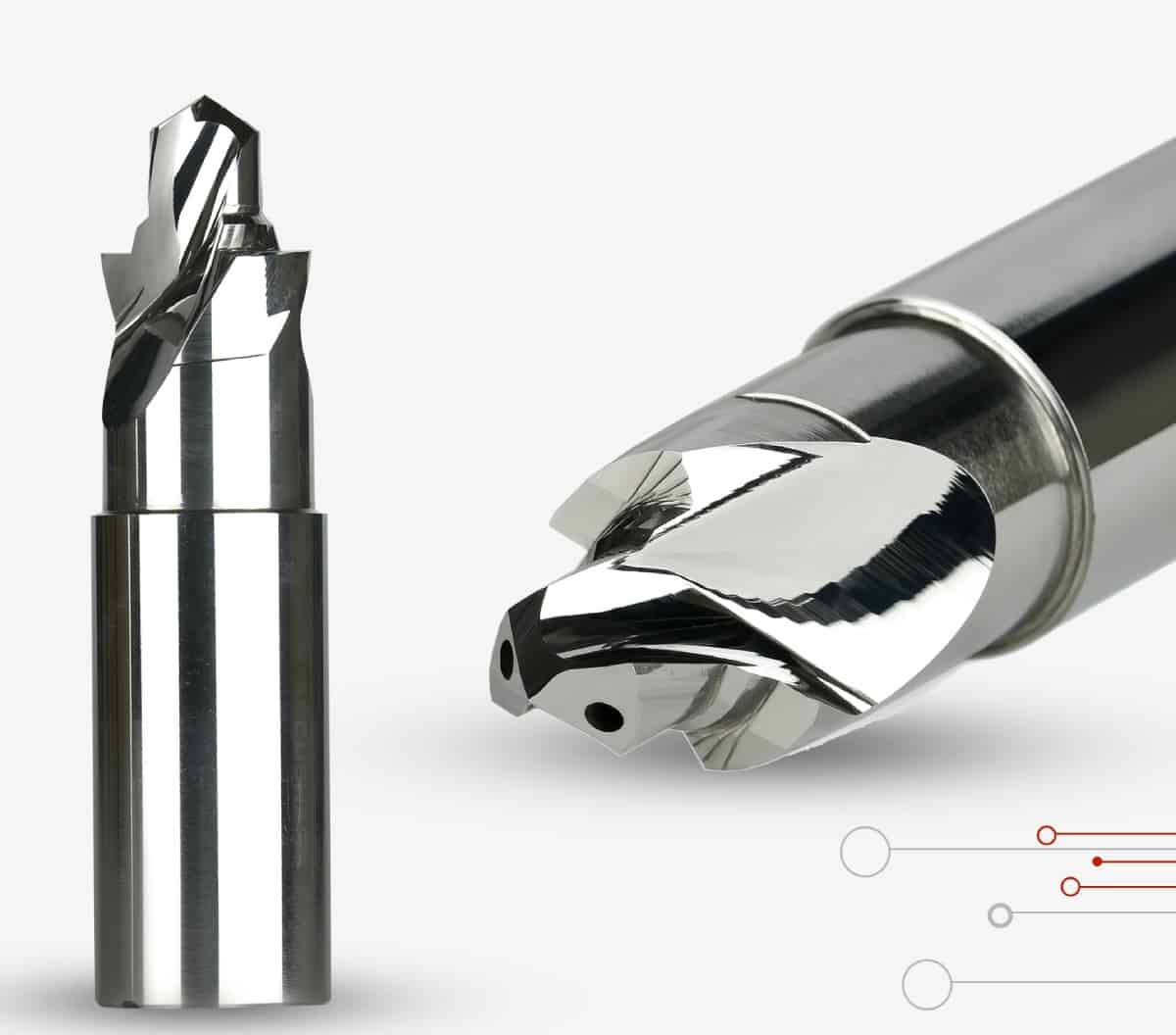Drilling is the most frequent method for making machined holes since it is easy, rapid and cost-effective.
One of the most difficult machining procedures is drilling. The combined cutting and extrusion of Metal at the chisel edge in the centre of the drill is the main feature that sets it apart from other Machining operations. The feeding motion’s high thrust force extrudes metal under the chisel edge first.Then, when a negative rake angle tool is used, it tends to shear.
The drilling machine settings indicate several key characteristics of this hole-making process.The Drill radius is most directly related to the depth of cut, which is a crucial dimension in other Cutting operations. The length of the drill lip, which is dependent on the point angle as well as the Drill size, is equal to the un-deformed chip width.The feed per lip is a more fundamental metric. It’s half the feed per revolution for a standard two-flute drill. Depending on the tip angle, the Un-deformed chip thickness varies from the feed per lip.
For every given operation, the spindle speed remains constant; however the cutting speed varies along the cutting edge. Normally, cutting speed is calculated based on the outside diameter. The cutting speed is zero in the centre of the chisel edge and proportional to the radius of any point on the lip. A key feature of drills is the variation in cutting speed along the cutting edges.
When the drill engages the workpiece, it remains in contact with it until it breaks through the Bottom of the part or is withdrawn from the hole. Drilling is similar to turning but not the same as Milling in this regard. Continuous cutting implies that constant forces and temperatures can be Expected soon after the drill makes contact with the work piece.
Drill:
A drill is a hole-making tool with an end-cutting tool. It has one or more cutting edges, as well as flutes that allow fluids and chips to pass through. A shank, body, and point make up the drill. Faster cutting speeds, longer tool life, greater positional and dimensional precision, and improved surface polish are all advantages of carbide drills. Accusharp Cutting Tools Manufacturers provides Carbide Drills of the highest quality, known for their outstanding performance, maximum torque capacity, and longer service life.
Accusharp cutting Tools Manufacturers developed cutting tools to provide exceptional accuracy while improving productivity and lowering costs.
Drill Parameters:
- Shank :
The shank of a drill is the part that is held and driven. It could be either straight or tapered. - Body :
The flutes are included in the drill’s body, which span from the shank to the point. The body of drill is partially ground away during the sharpening process. - Point :
The drill’s cutting end is the point. - Flutes :
Flutes are grooves carved or created into the drill’s body to allow fluids and chips to reach the tipand the workpiece surface.Straight flutes are occasionally employed, but they are usually helical. - Land :
After the flutes are cut, the land is the remaining outside of the drill body. To give clearance, the land is chopped back from the outside drill diameter. - Margin :
The margin is a small area of land that has not been cleared. It keeps the entire drill diameter. - Lips :
The lips are the drill’s principal cutting edges. They stretch from the drill’s chisel point to the drill’ periphery. - Web :
The web, which connects the lands, is the core section of the drill body. - Chisel edge :
The chisel edge is the edge ground on the tool point along the web. It joins the cutting lips together. - Axis :
The drill’s axis is also the tool’s centerline.It is perpendicular to the diameter and travels through the web. - Length :
The axial length of a drill is mentioned with its outside diameter when the drill size is specified.
In addition, shank, flute, and neck lengths are frequently utilized. - Body Diameter Clearance :
The body diameter clearance is the height of the step from the margin to the land. - Web Thickness :
The smallest dimension across the web is the web thickness.Unless otherwise stated; it is
Measured at the point. As you move up the body away from the point, the web thickness will
Often rise and you may need to grind it down during sharpening to minimize the size of chisel edge. This is referred to as “web thinning”. - Helix Angle :
The helix angle is the angle formed by the leading edge of the land and the drill axis. Drills with varied helix angles are offered to meet a variety of operational needs. - Point Angle :
The point angle is the included angle between the drill lips. It varies depending on the substance of the work piece. - Lip Relief Angle :
The lip relief angle corresponds to the common relief angles found on other tools. It is calculated at the outskirts. - Chisel edge Angle :
As seen from the end of the drill, the chisel edge angle is the angle formed by the lip and the
Chisel edge.Types of Drills- Solid Carbide Step Drill
- Solid Carbide TCH Double Margin Drills
- Micro Drills
- Carbide Center Drill
- Solid Carbide TCH Double Margin Long Drills
- Ratio Drill
- Carbide -Tipped Drills
- Oil Hole Drills
- Flat Drills
- Subland Drill
- Extra Length Drill
- Crankshaft Drill
- Extension Drills
- High Helix Drills
- Low Helix Drills
- Left Hand Drills
- Straight Flute Drills
- Multiple Fluted Drills
Drilling operations that are related:
Drilling encompasses a wide range of activities.Except for centering and spotfacing, which come
Before drilling; the most of the procedures in the following list come after drilling. Drilling must be
Used to create a hole, which must then be adjusted by one of the other processes.Reaming:
A reamer is used to enlarge a previously drilled hole, to provide a higher tolerance and to improve the surface finish of the hole.Tapping:
A tap is used to create internal threads in a hole that has already been bored.Counter boring:
To allow a bolt head to be seated below the part surface, counterboring creates a bigger step in holeCountersinking:
Countersinking is similar to counterboring, except the step is angled to allow flat-head screws to sit below the surface.Spotfacing:
Spotfacing is a process that gives an item a flat, machined surface.Centering:
Center drilling is used for accurately locating a hole to be drilled afterwards.Operating Conditions:
It’s difficult to offer specific criteria for speeds and feeds because of the wide range of settings underwhich drills are utilized. For drilling a range of materials, drill manufacturers and a number of Reference texts provide recommendations for optimum speeds and feeds.Drilling Speed:
Cutting speed is defined as the rate at which a point on a drill’s diameter travels in one minute. It’s measured in feet per minute on the surface (SFPM). Cutting speed is one of the most critical Criteria in determining how long a drill last. The will drill may chip or break if the cutting speed is too High a speed quickly dulls the cutting lips.Cutting speeds are determined by seven Factors:
- The type of material being drilled. (The harder the material, the slower the cutting speed.)
- The diameter and substance of the cutting tool. (The faster the cutting tool can manufacture the material, the tougher the material is.) The bigger the drill, the slower it has to spin.)
- Cutting fluids can be used in a variety of ways, which allows for faster cutting.
- The drill press’s sturdiness
- The drilling quality of the hole.
- The work environment’s rigidity.
- The drilling quality of the hole.
Before drilling a hole, each variable should be evaluated. Each variable is critical, but the work Material and cutting speed is the most critical.
Drilling Feed:
The optimal feed rate must be determined once the cutting speed has been determined for a certain work piece material and condition. Feed rates for drilling are chosen to enhance productivity while preserving chip control. In drilling operations, feed is measured in inches per revolution, or IPR which is the distance travelled by the drill in inches for each rotation.Drill Parameters:

Features:
- Specific point geometries
- Coated to maximize performance
- High efficiency
- Improved surface quality
- Smooth Flute Form
- High Accuracy
- Reliable high quality hole
Application Industry:
- Automotive Industry
- Aerospace
- Medical equipment Industry
- Bearing Industry
- Furniture Manufacturing
- Spring Manufacturing Industry
- Construction Industry
- Other manufacturing Industry


